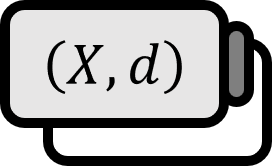Properties of Open and Closed Sets in Metric Spaces
Let $(X,d)$ be a metric space. Suppose $p \in X$ and $E \subset X$.
The set that contains all $q$s satisfying $d(q,p)<r$ is defined as the neighborhood of point $p$ and is denoted by $N_{r}(p)$. Here $r$ is called the radius of $N_{r}(p)$. When it’s possible to omit the metric, it can also be denoted as $N_{p}$.
If every neighborhood of $p$ contains $q$s with $q\ne p$ and $q\in E$, then $p$ is called a limit point of $E$.
If all the limit points of $E$ are contained in $E$, then $E$ is said to be closed.
If there exists a neighborhood $N$ of $p$ satisfying $N\subset E$, then $p$ is called an interior point of $E$.
If all the points of $E$ are interior points of $E$, then $E$ is said to be open.
Theorem
Let’s define $\left\{ O_{\alpha} \right\}$ as the collection of open sets and $\left\{ C_{\alpha} \right\}$ as the collection of closed sets in the metric space $X$. Then
(a) The union of open sets $\bigcup_{\alpha} O_{\alpha}$ is also an open set.
(b) The intersection of closed sets $\bigcap_{\alpha} C_{\alpha}$ is also a closed set.
(c) The finite intersection of open sets $\bigcap_{i=1}^{n}O_{i}$ is also an open set.
(d) The finite union of closed sets $\bigcup _{i=1}^{n} C_{i}$ is also a closed set.
Without the condition of being finite, $(c)$ and $(d)$ do not hold. This can be shown through a counterexample.
Proof
(a)
Let $O=\bigcup_{\alpha} O_{\alpha}$. If $p \in O$, for some $\alpha$, $p \in O_{\alpha}$. Therefore, by the definition of an open set, $p$ is an interior point of $O_{\alpha}$. Also, by the definition of an interior point, $p$ is an interior point of $O$. For any $p\in O$, since $p$ is an interior point of $O$, $O$ is an open set.
■
(b)
De Morgan’s Theorem Let $\left\{ E_{\alpha}\right\}$ be a collection of sets $E_{\alpha}$. Then the following formula holds. $$ \left( \bigcup \limits_{\alpha}E_{\alpha} \right)^{c}=\bigcap \limits_{\alpha} (E_{\alpha})^{c} $$
The proof is introduced below.
By De Morgan’s theorem, the following holds.
$$ \left( \bigcap_{\alpha} C_{\alpha} \right)^{c}=\bigcup_{\alpha}(C_{\alpha})^{c} \tag{1} $$
Since $C_{\alpha}$ is a closed set, $(C_{\alpha})^{c}$ is an open set. Therefore, by (a), $\bigcup_{\alpha}(C_{\alpha})^{c}=\left( \bigcap_{\alpha} C_{\alpha} \right)^{c}$ is an open set. Hence, $\bigcap_{\alpha} C_{\alpha}$, being the complement of an open set, is a closed set.
■
(c)
Let $O=\bigcap_{i=1}^{n}O_{i}$. Then, for any point $p\in O$, $p\in O_{i}\ (i=1,\cdots,n)$ holds for all $i$. Therefore, by the definition of an open set and an interior point, for each $i$,
$$ N_{i} \subset O_{i} \quad (i=1,\cdots,n) $$
a neighborhood of $p$ with radius $r_{i}$ exists. Let’s denote this by $r=\min (r_{1},\cdots,r_{n})$. Then, let $N=N_{r}(p)$. Since $N$ is the neighborhood with the smallest radius, the following holds.
$$ N\subset O_{i} \quad (i=1,\cdots,n) $$
Thus, $N \subset O$ holds and by the definition of an interior point, $p$ is an interior point of $O$. For any $p\in O$, since $p$ is always an interior point of $O$, $O$ is an open set.
■
(d)
By De Morgan’s theorem, the following holds.
$$ \left( \bigcup_{i=1}^{n}C_{i} \right)^{c} = \bigcap _{i=1}^{n} (C_{i})^{c} $$
Since $C_{i}$ is closed, by auxiliary theorem 2, $(C_{i})^{c}$ is open. Then, by $(c)$, $\bigcap_{i=1}^{n}(C_{i})^{c}=\left( \bigcup _{i=1}^{n}C_{i} \right)^{c}$ is an open set. Therefore, again by auxiliary theorem 2, $\bigcup _{i=1}^{n}C_{i}$ is a closed set.
■
Proof of De Morgan’s Theorem
part 1. $\left( \bigcup \limits_{\alpha}E_{\alpha} \right)^{c} \subset \bigcap \limits_{\alpha} (E_{\alpha})^{c}$
Let $x\in \left( \bigcup \limits_{\alpha}E_{\alpha} \right)^{c}$. Then, by the definition of the complement, the following holds.
$$ \begin{align*} && x &\notin \bigcup \limits_{\alpha}E_{\alpha} \\ \implies&& x&\notin E_{\alpha}\quad &\forall \alpha \\ \implies&& x&\in(E_{\alpha})^{c}\quad &\forall \alpha \\ \implies&& x&\in \bigcap\limits_{\alpha}(E_{\alpha})^{c} \end{align*} $$
Therefore,
$$ \left( \bigcup \limits_{\alpha}E_{\alpha} \right)^{c} \subset \bigcap \limits_{\alpha} (E_{\alpha})^{c} $$
part 2. $\left( \bigcup \limits_{\alpha}E_{\alpha} \right)^{c} \supset \bigcap \limits_{\alpha} (E_{\alpha})^{c}$
Let $x\in \bigcap \limits_{\alpha} (E_{\alpha})^{c}$. Then, the following holds.
$$ \begin{align*} && x &\in (E_{\alpha})^{c} &\forall \alpha \\ \implies && x &\notin E_{\alpha} &\forall \alpha \\ \implies&& x&\notin \bigcup \limits_{\alpha}E_{\alpha} \\ \implies && x &\in \left( \bigcup \limits_{\alpha} E_{\alpha} \right)^{c} \end{align*} $$
Therefore,
$$ \left( \bigcup \limits_{\alpha}E_{\alpha} \right)^{c} \supset \bigcap \limits_{\alpha} (E_{\alpha})^{c} $$
■
